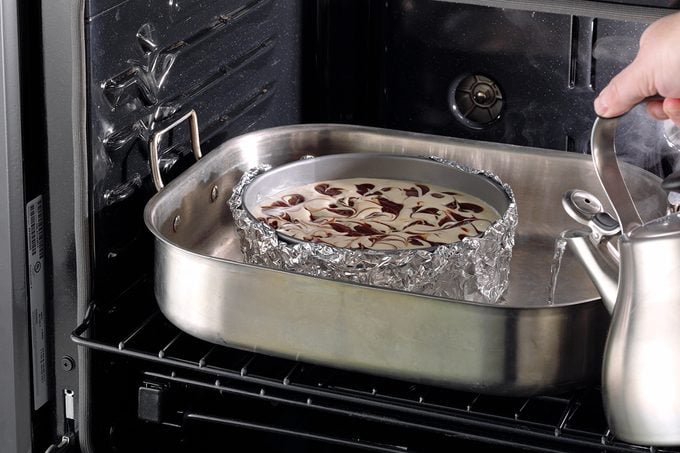How to Prevent (and Fix) a Cracked Cheesecake
Updated: Apr. 28, 2024

A big fear of every baker is a cracked cheesecake. Our Test Kitchen explains how to avoid these cracks (and how to patch them).
Cheesecake is one of our favorite desserts here at Taste of Home HQ, but it’s also prone to error (there are plenty of mistakes we’ve been guilty of making). One wrong move and you can end up with a giant crack that ruins the presentation. Isn’t that every baker’s worst nightmare?
But preventing cracks in your favorite cheesecake recipe is easy. To find out how to turn marred cheesecake into a thing of the past, I chatted with Catherine Ward, our prep kitchen manager and expert cheesecake baker, about why cheesecakes are prone to cracking and how you cand stop them.
What Causes a Cheesecake to Crack?
Before you can prevent cheesecake flaws, it helps to know what causes them. According to Catherine, there are two main reasons cakes crack.
First is that they are overbaked and dry. Dry cakes just don’t have the moisture needed to stick together in a single piece. For cheesecakes, it’s important to make sure you don’t overbake them.
Split tops also can occur as the cakes cool. As the cake cools, it contracts. If any part of the cake is stuck to the side of the pan as it cools and shrinks, it can pull and split.
How to Prevent a Cracked Cheesecake

To keep your cheesecake from cracking, Catherine says there’s no single technique that’ll do the trick. Instead, she recommends a handful of techniques that help ensure success.
Grease the pan
“Yes, even if it’s nonstick,” Catherine says. Cheesecakes often crack as they cool and contract. If any of the cake sticks to the edge, it can pull on the edge of the cake as it contracts and create a gash. Catherine recommends a quick coat of cooking spray just to be sure.
Don’t overbeat the eggs
“Wait to add your eggs until the last step,” says Catherine, “and beat until just combined—not more.”
She explains that the more you mix eggs into the cheesecake batter, the more air you incorporate. The more air you have in your batter, the more you cheesecake is likely to expand, contract and then crack.
Always use a water bath
A great way to avoid cracked cake is to use a water bath, even if the recipe doesn’t specify this technique. Our Test Kitchen uses a water bath on every single cheesecake, and look how beautiful they turn out!
To create a water bath (also called a bain-marie), all you need is a high-sided pan and hot water. Set your cake pan inside the water bath (it’s a good idea to wrap it in foil—even if it says leak-proof!) and fill the pan with boiling water. Then bake as normal.
The water bath helps bake the cake more evenly and “it provides a moist atmosphere that’ll keep it from drying out and cracking,” says Catherine.
Keep the cheesecake away from the top of the oven
Cracks can also occur when the top of the cake bakes too quickly. To prevent your cheesecake from getting too brown up top, Catherine recommends moving down the cake just a bit in the oven.
Yes, the middle rack is typically the best rack for baking, but for cheesecake, it’s important to leave some breathing room. You don’t need to move your rack to the very bottom, but moving it down just a rung from the middle can do wonders, according to Catherine.
Don’t overbake
It can be tempting to bake a cheesecake until the center is set as you would with a traditional cake, but Catherine says once the center of a cheesecake is set, it’s actually overbaked—and overbaked cheesecakes are liable to crack.
To check if your cake is done, you can conduct a quick wobble test. To do this, tap the side of your springform pan with a wooden spoon. If the cake ripples, it’s not there. If it wobbles slightly and moves as a whole, it’s done baking.
Run a knife around the edge
Once you’ve removed the cake from the oven and let it cool about ten minutes, Catherine says to run a dull knife around the edge of the pan. This will ensure nothing is sticking to the inside rim to cause the cake to split.
How to Fix a Crack in Your Cheesecake

Unfortunately, once you’ve got a crack in your cheesecake, you can’t exactly mend it; it’s there to stay. Luckily enough, imperfect cheesecakes still taste great and you can disguise the cracks pretty easily.
Catherine recommends topping your cheesecake with fresh whipped cream. You can also mask all manner of flaws with fresh fruit or even homemade chocolate ganache like on this mint-chocolate cheesecake. And really, who wouldn’t like a little extra cream, fruit or chocolate on their dessert?



















